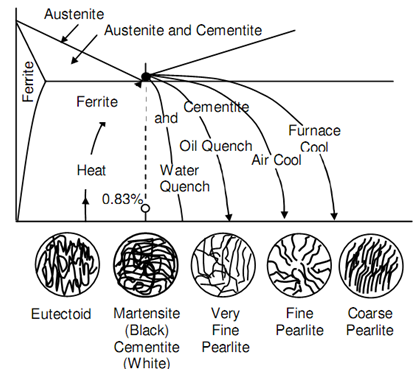Cooling Rate and Quenching Media
Rate of cooling plays a significant role in calculating the last structure subsequent to quenching in case of eutectoid steel. Following figure schematically demonstrates four different structures that are acquired cooling rates while austenitized steel is cooled in four various media.

Figure: Microstructure resulting from Different Cooling Rates Applied to Austenitized Samples of Eutectoid Steel
Just the drastic water quench generates a fully martensite structure. Although quenched in oil the austensite converts into suitably fine pearlite. Accurate pearlite also results if the austenised eutectoid steel is air-cooled. Though, if allowed to cool in furnace coarse pearlite is appearance. These effects have previously been considered beneath the headings of annealing and normalizing. Though, it might be mentioned that properly fine pearlite structure such is acquired from oil quenching is identify primary troostite. Table no.9 illustrates the effects of several cooling media on mechanical properties of eutectoid steels.
Table no.9: Mechanical Properties of Eutectoid Steels after Cooling in various Quenching Media
|
Cooling
Media
|
Structure
|
UTS (N/mm2)
|
Y. S. (N/mm2)
|
Hardness
(Rc)
|
Elongation % (50 mm g. L)
|
|
Water
|
Martensite
|
1700
|
-
|
65
|
Low
|
|
Oil
|
Troostite
|
1100
|
550
|
35
|
5
|
|
Air
|
Fine pearlite
|
850
|
270
|
25
|
8
|
|
Furnace
|
Coarse pearlite
|
520
|
140
|
15
|
12
|
Water is the expensive quench media for plain carbon steels. Though, while utilizing water care must be exercised that water is appropriately agitated during such treatment or else air bubbles might be trapped on the surface and insulate the spots from that heat flow will be delayed. That type of spots will enhance softness. Brine or Salt water is extra severe quenching media as this removes heat faster. Though, in this condition the steel should be thoroughly cleaned after quenching or else the surface begins to rust. For extremely low carbon steels hydroxide solutions are often utilized instead of brine. If slower cooling rates are preferred, the steel might be quenched in oil along with high flash points. Various type of grades of quenching oil are obtainable. High C steels are invariably quenched in oil as water quenching will improve cracks in such steels.